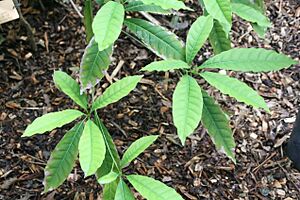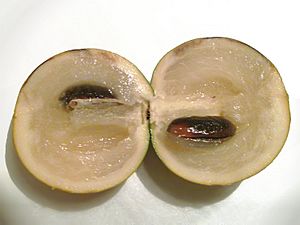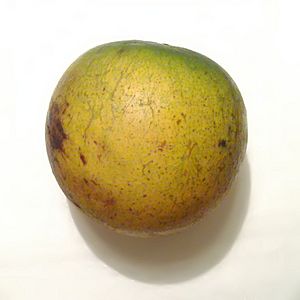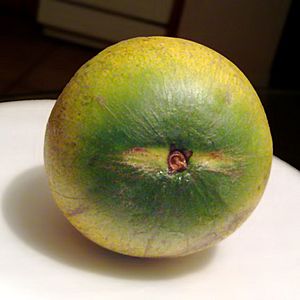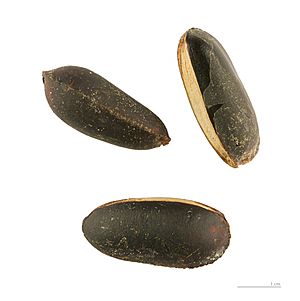Abiu facts for kids
Quick facts for kids Abiu |
|
|---|---|
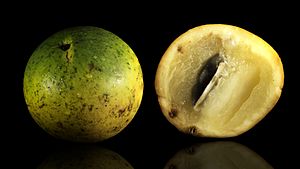 |
|
| Fruits | |
| Scientific classification | |
| Genus: |
Pouteria
|
| Species: |
caimito
|
The abiu (scientific name: Pouteria caimito) is a cool fruit tree from the Amazon rainforest in South America. It usually grows about 10 meters (33 feet) tall. But in really good conditions, it can reach an amazing 35 meters (116 feet)!
Abiu fruits can be round or oval, with a pointy end. When they're ready to eat, they have smooth, bright yellow skin. Inside, the fruit is clear and white, with a creamy, jelly-like feel. It tastes sweet, a bit like caramel custard, similar to a sapodilla fruit. The abiu tree is related to the canistel and belongs to the Sapotaceae family.
Contents
Where Does Abiu Grow?
The abiu fruit is originally from the areas near the start of the Amazon River. You can find it growing wild in the lower eastern parts of the Andes mountains, from Venezuela all the way to Peru. It's also common in places like Ecuador, where you can buy it in local markets.
Long ago, native people in the Americas grew abiu. It became very common across the Amazon. Today, it grows a lot in northern Brazil, and you can also find it in Colombia and other parts of Venezuela. It has even been growing in Trinidad for a long time!
Abiu trees love warm, moist weather all year round. That's why they do so well in the Amazon basin. You might see them growing in people's backyards or along streets in Brazilian towns. It has also been introduced to other parts of the world, like the Pacific island of Tahiti since 1993.
What Does the Abiu Tree Look Like?
The leaves of the abiu tree are usually long and oval-shaped. They can be about 10-20 cm (4-8 inches) long and 3.5-6.5 cm (1.5-2.5 inches) wide.
The flowers grow on the tree either alone or in small groups of two to five. They appear on thin branches where the leaves meet the stem. These flowers are small, with four or five petals that are white to greenish. Abiu flowers are hermaphroditic, which means each flower has both male and female parts. They open in the morning and stay open for about two days.
All About the Abiu Fruit
A mature abiu tree can produce anywhere from 100 to 1000 fruits each year! The inside of the fruit is pale and clear, with a soft, custard-like texture. It's easy to scoop out with a spoon. The seeds are also easy to remove and have a thin layer of fruit pulp on them.
The fruit has a sweet, mild taste. Some people say it has a hint of pineapple, but it's often described as tasting like caramel flan. It's great to eat fresh, or you can use it to make ice cream.
When abiu fruits are not ripe, they have a sticky, gummy liquid called latex. This latex hardens when it touches the air. The skin of a ripe fruit is pale yellow and feels a bit leathery, and it might still have some sticky latex.
Good news! Abiu fruits continue to ripen even after they are picked. This means farmers can pick them and then transport them to markets. You can tell a fruit is getting ripe when its color changes from pale green to yellow. A fully ripe fruit will be completely yellow and feel slightly soft.
Different Kinds of Abiu
Abiu fruits can be quite different in their shape, size, and how good they taste. Some have soft flesh, while others are firmer. Some might taste plain, but many have a wonderful flavor.
In Colombia, there's a type of abiu that grows large, round fruits after about four years. Another type in Colombia produces fruit just one year after planting, but these fruits are smaller and don't have as much pulp.
When is Abiu Season?
Abiu trees can flower several times a year. This means you might see both flowers and fruits on the tree at the same time! It takes about three months for a flower to turn into a ripe fruit. The main time for harvesting abiu depends on the climate.
In Ecuador, fruits are usually in season in March and April, but they can also appear at other times. In some markets in Brazil, they are sold from September to April, but they might be harder to find then. In Florida, the fruits ripen from August to October. In northern Queensland, Australia, the main harvest is from January to March.
How is Abiu Used?
The wood from the abiu tree is strong, heavy, and hard. People use it for building things.
Eating Abiu
The abiu fruit is delicious and edible! Many people think it's one of the best "sapote" fruits because of its sweet, caramel-like taste and smooth texture. It's often eaten fresh. In Colombia, some people suggest greasing your lips before eating it fresh to avoid the sticky latex, but you can easily avoid this by choosing fully ripe fruits and scooping out the flesh with a spoon.
Adding a little bit of lime juice can make the flavor even better, especially if the fruit is chilled. The sweet, melting pulp of abiu is also used to flavor ice cream or mixed into yogurt for a light and tasty breakfast. Because its flavor is mild, it's usually not used in very fancy desserts or salads. Abiu fruit is also a good source of important nutrients like calcium, phosphorus, vitamin A, and vitamin C.
Growing Abiu Trees
Abiu trees grow best in tropical areas where the climate is warm and moist all year. They are a bit more sensitive to cold than other similar fruit trees like the canistel. In the United States, abiu grows well in South Florida and can even survive short periods of freezing temperatures.
These trees prefer wet, slightly acidic soil that has a lot of organic material. They might have trouble getting enough iron in soils that are too alkaline. When you first plant an abiu tree, it's delicate and needs protection from strong winds and cold weather. You only need to trim the tree a little bit, and it's good to feed it often with small amounts of fertilizer.
How to Grow New Abiu Trees
Most of the time, new abiu trees are grown from seeds. However, the fruits from these seedling trees can be different from the parent tree. Fresh seeds need to be planted within a few days to grow, and they usually sprout in two to three weeks.
You can trim the lower branches of a young tree after about a year. You can expect the first fruits in about three years, and a lot more fruit after five years. To get fruits faster or to grow specific types of abiu, people can use methods like grafting (joining parts of two plants), budding, or air layering.
Pests and Diseases
In its native home, the abiu fruit can sometimes be damaged by small insects. In Brazil, the main pest that harms the fruit is the fruit fly. Tiny insects called thrips can also attack the buds, leaves, and young fruits. However, in places where abiu is not native, it can often grow without many pests, especially if the fruits are picked when they are mature and allowed to ripen off the tree.
See also
 In Spanish: Pouteria caimito para niños
In Spanish: Pouteria caimito para niños


